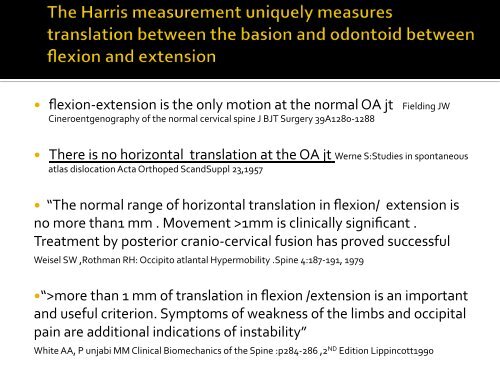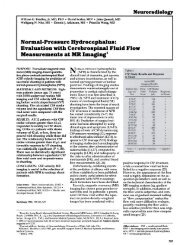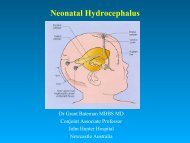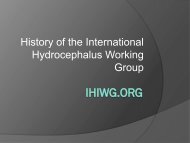Recognition of Cranio-Cervical Instability in the Complex Chiari ...
Recognition of Cranio-Cervical Instability in the Complex Chiari ...
Recognition of Cranio-Cervical Instability in the Complex Chiari ...
Create successful ePaper yourself
Turn your PDF publications into a flip-book with our unique Google optimized e-Paper software.
flexion-‐extension is <strong>the</strong> only motion at <strong>the</strong> normal OA jt Field<strong>in</strong>g JW<br />
C<strong>in</strong>eroentgenography <strong>of</strong> <strong>the</strong> normal cervical sp<strong>in</strong>e J BJT Surgery 39A1280-‐1288<br />
There is no horizontal translation at <strong>the</strong> OA jt Werne S:Studies <strong>in</strong> spontaneous<br />
atlas dislocation Acta Orthoped ScandSuppl 23,1957<br />
“The normal range <strong>of</strong> horizontal translation <strong>in</strong> flexion/ extension is<br />
no more than1 mm . Movement >1mm is cl<strong>in</strong>ically significant .<br />
Treatment by posterior cranio-‐cervical fusion has proved successful<br />
Weisel SW ,Rothman RH: Occipito atlantal Hypermobility .Sp<strong>in</strong>e 4:187-‐191, 1979<br />
“>more than 1 mm <strong>of</strong> translation <strong>in</strong> flexion /extension is an important<br />
and useful criterion. Symptoms <strong>of</strong> weakness <strong>of</strong> <strong>the</strong> limbs and occipital<br />
pa<strong>in</strong> are additional <strong>in</strong>dications <strong>of</strong> <strong>in</strong>stability”<br />
White AA, P unjabi MM Cl<strong>in</strong>ical Biomechanics <strong>of</strong> <strong>the</strong> Sp<strong>in</strong>e :p284-‐286 ,2 ND Edition Lipp<strong>in</strong>cott1990








